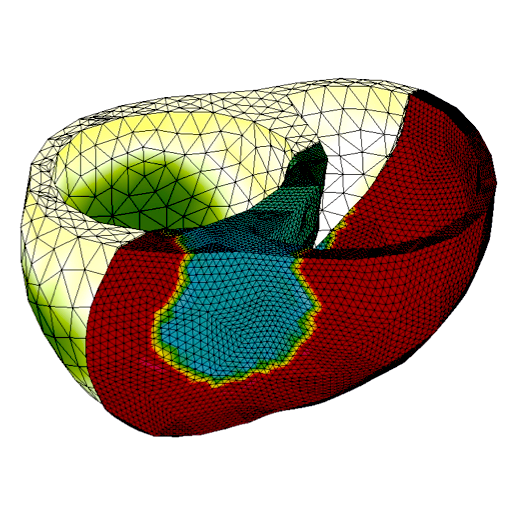
A Flexible High Performance Approach to Cardiac Electromechanics
Simulating the heart activity has turned out to be one of the "Grand Challenges" in computational sciences. The most advanced competences in mechanics and electrophysiology contribute to construct a complete model describing the leading mechanisms underlying every single heartbeat. The aim of the project is to develop and realize a fully coupled electromechanical model of the heart.
The subject of cardiac mechanical studies is the elastic behaviour of the heart muscle. To describe the mechanical behaviour of the heart many anatomically detailed finite-elements models are available in the literature. Those models describe the heart as a hyperelastic, nearly incompressible orthotropic material [M. Kroon and G. Holzapfel, 2009]. They are based on physical principles such as conservation of work and balance of momentum.
Appropriately fitted numerical strategies to deal with the saddle-point structure of the arising system are needed. The mechanical activation of the tissue is driven by the electrical signal propagating throught the cardiac muscle. Our mechanical software has been validated [S. Land et al,; 2015].
The propagation of electrical signals in biological tissues is the subject of cardiac electrophysiology studies. The activation sequence of the heart is driven by ionic exchanges across the cell membrane. Thanks to the help of active pumps, cells maintain a difference in ion concentration between the interior and the exterior of the cell. Following the idea, initially proposed by Hodgkin and Huxley [A. Hodgkin and A. Huxley., 1952], many models of cardio electrical activation have been proposed in the literature.
Electrophysiological and mechanical processes take place at different spatial and temporal scales. Fully coupling these processes, correct and simulation of cardiac activity. New staggered and monolithic solution techniques are developed, investigated and compared.
Prof. Dr. Rolf Krause; CCMC
PhD Marco Favino; Researcher; CCMC
Mrs. Sonia Pozzi; Researcher; CCMC
Swiss National Science Foundation grant 149828;
Theo Rossi di Montelera Foundation;
Metis Foundation Sergio Mantegazza;
Fidinam Foundation;
Horten Foundation;


